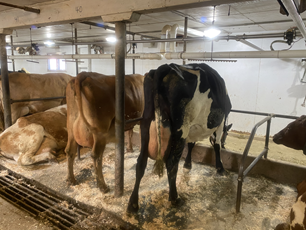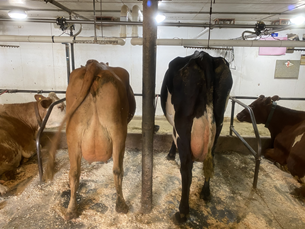By Allen Williams, Ph.D.
Genetic selection is something that is often complicated and confusing for many livestock producers. There are numerous trait measurements that we try to decipher, including breeding values and EPD’s that we pour through and try to interpret. We like to use weighted or adjusted values for various traits. In the past couple of decades, we have added DNA Marker technology to the mix. We read breed-promotion literature, look at the glossy pictures in breed association catalogs, ask neighbors and friends what they are using. Some of us may pay attention to the sale barn owners and operators, to the feedlot managers, to the packer or processor, to whomever is selling us something, or to our lender.
Context
The one glaring item that is missing from any of these sources is context. Your context. Any genetics you select must work at your farm, under your management, and must generate reasonable net profits. No one else can provide your context. You know your goals and objectives, you know what your challenges are on your farm, you know what your economics are.
What are the most important traits relative to net profitability and productivity? They are longevity, adaptability, fertility, and soundness. These are traits that are very hard to properly measure and ascertain using breeding values, EPD’s or DNA Markers. Why? Because none of those address your specific farm context.
Most Profitable
For more than 15 years, I worked with the IRM SPA program and collected data from many beef farms across multiple regions. What I found was that the most profitable operations were not those that had the highest weaning weight calves, the highest annual pregnancy rates, the greatest ribeye area or the highest marbling. The average beef cow in the dataset was culled after 4.3 calves. This included culling for not breeding as a virgin heifer, failing to rebreed after her first calf, poor udder, or other reasons. However, based on investment in each cow, it took an average of 5 calves before that cow breaks even. That means the average cow never made any net profit for her owner. The beef farms with the highest net profits year after year were not those with the greatest performance in any of the traits that we typically use for our selection protocols. They were the ones whose cows had superior longevity. To possess superior longevity, cows have to be highly adapted to your farm and management, able to breed back and produce a live calf every 365 days and have a higher degree of soundness.
Knocking out the Props
Livestock that perform on your farm without having to rely on a high degree of inputs are the ones you want to select for. Can they survive and thrive without all the props? Are they mostly trouble free? How do you determine whether they are trouble free livestock? You have to knock out all the props and stop treating individual animals differently. You also have to stop mass treating all animals in your herd for parasites, respiratory issues, or other issues. This is the only way to expose those who are more susceptible to these issues. Once exposed, cull them at the earliest convenience and at best market opportunity. Stop making any excuses for animals that do not perform as well and are not well-adapted to your environment.
By formal training, I am a geneticist and physiologist. I spent way too many years thinking I knew how to select superior breeding stock. I poured through EPD’s, through individual trait data, linear measurements, and other data points. I kept different age groups separate. I managed for the weak in the group and not the strong, meaning I catered to those who were not nearly as well adapted. I would put first calf heifers in a calving pasture and check on them every 4 hours around the clock. I thought I was being an excellent husbandman, but I was really facilitating calving issues and selection of less than desirable genetics.
So, what do I do now? I no longer spend inordinate amounts of time measuring specific traits, studying EPD’s or other genetic indicators. I no longer have a “heifer calving pasture.” I no longer spend every four hours checking calving heifers. All heifers, regardless of measurements or other genetic indicators, get a chance to breed to calve as a two-year old. Bulls are turned in for 60 days. Approximately 30 days after bulls are removed, I ultrasound pregnancy test the heifers. Those that are confirmed pregnant are put back in with the cow herd and will spend the rest of their productive lives there. Those that are open are moved to the grass finishing herd and become sellable end product. I do not strive for 85% or 90% pregnant heifers. I simply let nature and the heifer’s adaptability to my environment determine their breed-up percentage. If they are bred, great. I have replacements and maybe additional bred heifers to market as breeding stock to someone else. If they are open, I turn them into high-quality grass-fed beef.
What has happened? Calving issues, especially abnormal presentations have practically disappeared. I do not have to keep a separate pasture for heifer calving and interrupt my grazing management. I do not have to spend every four hours checking calving heifers. The heifers that best fit my environment, including my management, are the ones that breed and become the new cows. The rest become meat and no longer propagate inferior genetics. First calf heifers get checked once daily when the cow herd is moved to their new paddock. This has eliminated the vast majority of our problems and has created a herd that is mostly trouble free. They require far fewer inputs and perform far better.
What About Dairy?
For decades now, selection in many dairy herds has been centered around fluid milk production with some selection pressure on components. This has caused the gene pool to excessively narrow and led to cows that are highly productive as individuals, when fed high amounts of feedstuffs and catered to. Unintended consequences resulting from this selection philosophy has led to cows that are large framed, high maintenance, and possess low longevity.
The pictures below show a contrast between two cows in the same dairy herd located near Cold Springs, MN. One is a Jersey-cross cow and the other is a Holstein. Both were born in the same month in the same year and are in their second lactation. The day that I took these pictures they just happened to stand side-by-side in the barn while being milked. I immediately noticed the contrast and had to ask the owner several questions. He explained that his records indicated the Jersey cow ate about 70% of what the Holstein consumed daily. It is clear that there is a distinct body condition difference between the two. The Jersey has maintained a far better BCS than the Holstein, in spite of the Holstein eating 30% more feedstuffs daily. The Jersey is certainly more moderate in frame score. A look at the udders reveals that the Jersey has excellent attachment and conformation, while the udder of the Holstein is already starting to show signs of weakening and breaking down. That Jersey was actually producing slightly more total milk with higher components compared to the Holstein.


In talking with the producer, he noted that that Jersey would likely last eight-plus lactations in his herd while the Holstein would be culled after the current lactation. Which cow will make him more money over their lifetime? The answer is obvious. He could cater to the Holstein and provide her with all she needs, but she will still be inferior, and any heifers produced from her would be inferior. By culling her and not using her heifer calf as a replacement, he is selecting for cows that fit his environment and will be far more profitable.
Summary
We are often our own worst enemy in terms of genetic selection. Letting nature help us with our selection often is far more advantageous and profitable. I believe that Robert Bakewell (1700’s England) had it right with his three principles of genetic selection: 1) Have an “Ideal Type,” 2) Breed the best to the best regardless of relationship, and 3) Progeny test. Bakewell never knew what genes, DNA, chromosomes were. He never knew what EPD’s, Breeding Values, or DNA markers were. However, he would beat the socks off of almost every modern-day animal breeder following his three principles only. We can do the same.
